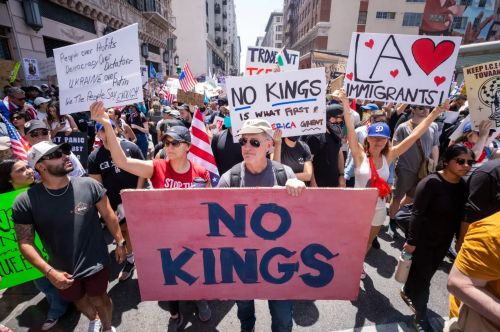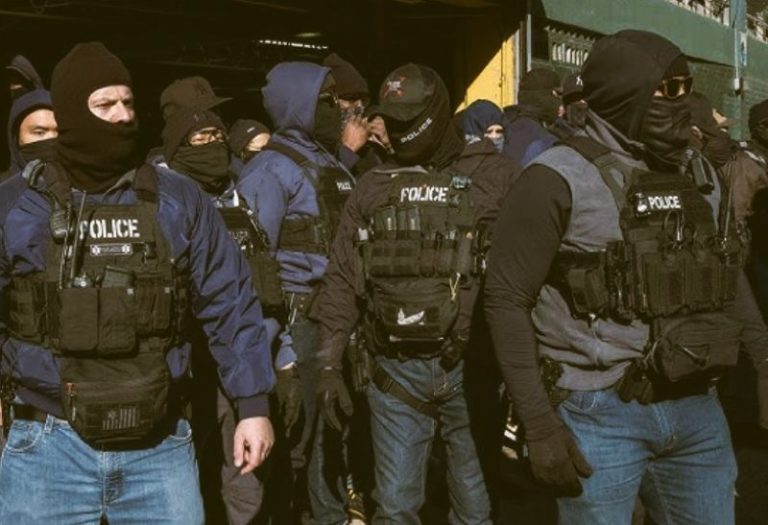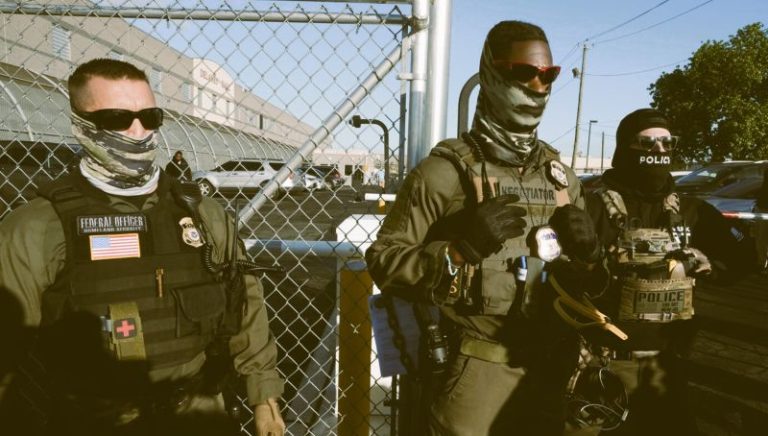

Every generation of Americans inherits the same unfinished task, to decide whether liberty is a living principle or a convenient slogan.

By Matthew A. McIntosh
Public Historian
Brewminate
Introduction
When President Donald Trump returned to office in January 2025, his administration moved quickly to consolidate power: tightening federal control over universities, policing dissent, and rewarding states that fell in line with its agenda. But across the country, a quiet network of citizens, students, and community leaders has been organizing to push back, not with violence, but with the same democratic tools the Constitution guarantees.
In New York, the “Hands Off NYC” coalition formed to resist the administration’s threat to withhold funding from cities deemed “non-compliant” with federal directives. In Rhode Island, protesters urged Brown University to reject a Trump administration compact that critics say would undermine academic independence. Across campuses and city halls, the message is spreading: resistance is not rebellion, and dissent is not disloyalty.
The United States has reached another of its defining moments, one that will test whether ordinary citizens still understand the rights they possess, and whether they will use them. This article does not call for violence in any form. Instead, it examines the peaceful, constitutional means available to Americans who refuse to let authoritarian power take root: speech, assembly, protest, and persistence.
The Threat: What Are We Resisting?
Since returning to the White House, Trump has pursued what critics describe as an increasingly authoritarian agenda. He has replaced key civil service positions with loyalists, threatened to deploy the National Guard in cities that defy his directives, and targeted universities and media organizations that question his policies. The effect is not simply political; it is structural, aimed at reshaping the limits of executive power itself.
Civil liberties groups warn that these moves represent a pattern rather than isolated decisions. The American Civil Liberties Union has documented ongoing attempts to weaken the Department of Justice’s independence, curtail protest rights, and punish federal employees who refuse political loyalty tests. In some cities, local officials have been pressured to accept federal “security partnerships” that critics say erode state sovereignty and invite surveillance of peaceful demonstrators.
Recent protests illustrate the dangers of unchecked federal reach. In Chicago, a lawsuit filed by journalists and activists accuses federal agents of using excessive force and intimidation during an immigration protest. In Washington, the administration’s proposed “Patriotic Education Compact” has raised alarms among academics and historians who view it as a bid to censor dissenting perspectives in schools and universities.
These developments are not theoretical concerns. They mirror the early playbooks of other leaders who concentrated authority under the guise of national renewal. The risk lies not only in what power does, but in what citizens permit it to do, through silence, exhaustion, or fear. Constitutional democracy depends on resistance from below: ordinary people insisting that their government remain accountable to law, not loyalty.
The Power of the Citizen within the Law
For all the power a president holds, the Constitution still belongs to the people. The First Amendment remains the most potent shield against authoritarian overreach, guaranteeing the right “to assemble, and to petition the Government for a redress of grievances.” When used strategically, those words become more than parchment promises; they are instruments of accountability that can limit even the strongest executive.
Nonviolent action has repeatedly proven its force throughout American history. From the Montgomery bus boycott to the women’s suffrage marches, peaceful resistance has transformed policy and culture alike. As researchers at Harvard’s Carr-Ryan Center for Human Rights note, nonviolent movements are often twice as effective as violent ones in achieving sustainable political change. The lesson is not moral alone; it is practical. Violence invites repression. Nonviolence exposes illegitimacy.
Modern organizers have echoed that logic in the face of Trump’s renewed attempts to punish dissent. The Hands Off NYC coalition, for instance, has mobilized through coordinated citywide demonstrations, leveraging media attention and legal partnerships to challenge federal threats. Across the country, small networks of volunteers are quietly teaching citizens how to document protests, contact attorneys, and protect themselves from retaliation, practical resistance rooted in law, not defiance for its own sake.
Empirical evidence underscores the impact of collective civic engagement. Studies cited by the Center for American Progress show that when roughly 3.5 percent of a population participates in sustained nonviolent action, governments often yield or reform. In the United States, that would mean about twelve million people, a fraction of the country, yet enough to alter its course.
The power of citizenship lies not in confrontation, but in consistency: showing up, speaking out, organizing locally, and invoking the very rights an autocrat would prefer to silence. Every petition filed, protest held, and article written is a reaffirmation that democracy, though fragile, is still functional when its citizens remember how to use it.
Examples in the Field
Across the country, resistance to authoritarian policy is not abstract: it’s visible in streets, classrooms, and city councils. Each movement is distinct in its cause, but united in a shared conviction that power must answer to the governed.
In New York, the “Hands Off NYC” coalition has rallied unions, faith leaders, and community groups to oppose what it calls a “federal overreach into local governance.” Their demonstrations, staged outside federal buildings and police precincts, emphasize peaceful defiance, chanting, singing, and reading the Bill of Rights aloud in unison. Organizers say their purpose is not to obstruct law enforcement, but to remind it of constitutional limits.
At Brown University in Rhode Island, students and faculty are urging administrators to reject a proposed funding agreement with the Trump administration that critics claim would tie grants to “patriotic education” standards. Protesters gathered on the Main Green, holding signs that read “Knowledge Is Not Loyalty” and “Resist the Compact.” Their goal is to preserve academic freedom, a principle increasingly under threat as universities face political scrutiny.
Earlier this year, the No Kings protests drew an estimated five million Americans into the streets of more than two thousand cities. The movement, organized through social media and local activist networks, demanded that Congress reassert oversight authority and condemn executive overreach. Participants described it as a defense of civic dignity, echoing the 1963 March on Washington’s nonviolent discipline and clarity of purpose.
Other campaigns have taken quieter forms. In Georgia, clergy have formed interfaith circles to discuss nonviolent civil disobedience in defense of voting rights. In California, retired judges and lawyers are offering free workshops on constitutional law and protest safety. And across the Midwest, a coalition called Good Trouble Lives On, inspired by John Lewis’s legacy, is organizing town-by-town teach-ins on how to lawfully challenge unjust directives while maintaining peace and restraint.
What binds these efforts is not ideology but vigilance. Each draws from an American tradition older than any single presidency: the belief that citizenship itself is an act of resistance when freedom is at risk.
Risks, Pitfalls, and Ethical Guardrails
Resistance, even when peaceful, is never without risk. The line between lawful dissent and perceived disorder can shift quickly under an administration inclined to criminalize opposition. Protesters have already faced heightened surveillance, selective prosecution, and rhetoric that brands them as “domestic enemies.” These are old tactics repackaged, designed to isolate movements by making citizens fear participation more than oppression itself.
Civil rights attorneys and advocacy groups have been warning organizers to prepare for potential escalation. The American Civil Liberties Union has developed its “Know Your Rights” site, emphasizing the importance of understanding local ordinances, avoiding unnecessary confrontation, and documenting all interactions with law enforcement. In Washington and Chicago, legal observers have become fixtures at rallies, ensuring that any abuse of authority can be recorded and challenged in court.
Nonviolent resistance demands discipline. History shows how easily a peaceful demonstration can be undermined by provocation, whether from agitators seeking chaos or from police responses that escalate tension. Organizers are now placing greater emphasis on de-escalation training, designating “peacekeepers” within crowds to calm disputes before they spiral. The lesson is as practical as it is moral: maintaining credibility depends on restraint.
Activists also face emotional and physical fatigue. Sustained protest can wear people down through exhaustion, fear, and disillusionment. Grassroots leaders have begun building mutual aid networks to provide food, transportation, and mental health resources to participants. These systems mirror those used during the civil rights era, when resilience was as essential as courage.
The ethical boundaries of resistance are equally critical. To defend democracy through violence would only vindicate those who seek to destroy it. Peaceful defiance, rooted in constitutional principles, remains the surest way to expose illegitimate power. As one organizer in New York put it, “We can’t outfight authoritarianism. We have to outlast it.”
What Resistance Looks Like, Step by Step
In practice, resisting authoritarianism does not require heroism; it requires participation. Every citizen has access to a small but powerful set of tools that, when used collectively, can shift the balance between obedience and accountability.
The first step is education. Citizens must understand their constitutional protections before they can invoke them. Groups like the Brennan Center for Justice and the American Constitution Society have published guides explaining how local ordinances, federal statutes, and court precedents define the limits of government authority. Knowing what the law allows is the surest defense against intimidation.
Second, resistance begins locally. Change often starts in school boards, city councils, and statehouses, the levels of government most insulated from presidential power. By organizing petitions, attending public meetings, and running for small offices, citizens build democratic muscle that cannot be suppressed from above. When coordinated across communities, these local movements form the backbone of national pressure.
Third, protest remains essential, but strategy matters. Peaceful marches, sit-ins, and symbolic actions remind the public that dissent is not chaos but conscience. Organizers encourage participants to document events, remain calm in the face of provocation, and engage journalists whenever possible. Visibility, not violence, is what undermines authoritarian control.
Fourth, legal preparedness must be part of every movement. Before attending a demonstration, citizens are urged to know whom to call if detained, how to identify legal observers, and what rights they retain when questioned. Organizations such as the ACLU provide printable cards detailing these protections, a modern equivalent of the pocket Constitution that once guided earlier generations of reformers.
Finally, movements must sustain themselves beyond moments of outrage. Grassroots networks, faith communities, unions, and online coalitions are now coordinating mutual support systems to share resources and keep morale alive. The lesson from history is simple: authoritarianism thrives on fatigue. The more citizens collaborate, the longer democracy endures.
Peaceful resistance, pursued methodically and lawfully, is not a fringe activity. It is the continuation of America’s oldest civic tradition, the people reminding their government who it serves.
Why This Matters and What Success Might Look Like
The health of a democracy is measured not by the strength of its leaders but by the vigilance of its citizens. Autocracy rarely arrives in a single coup; it seeps in through apathy, convenience, and the slow erosion of boundaries once thought unbreakable. What Americans choose to do now, or fail to do, will decide whether constitutional rights remain living guarantees or relics of memory.
Peaceful resistance is not only about stopping one administration. It is about reaffirming the civic habits that keep power accountable. Each protest, lawsuit, and editorial builds precedent for future generations, proving that democracy does not protect itself. The Freedom House 2025 report warns that the United States, while still rated “free,” is showing “declining institutional resilience” as public trust wanes. Reversing that trend begins not in Washington, but wherever people act on conscience instead of fear.
Success in this struggle will not look like a single victory. It will look like communities refusing to normalize abuses of authority. It will look like journalists reporting without censorship, teachers teaching truth without state interference, and voters participating without intimidation. It will look like Americans rediscovering the courage to disagree in public and still believe in the rule of law.
Authoritarianism depends on surrender. Democracy depends on endurance. If citizens continue to organize, speak, and vote with purpose, the system can still hold. History suggests that even entrenched autocrats falter when legitimacy erodes faster than control. That erosion begins the moment people remember that resistance (lawful, persistent, collective) is a civic duty, not a radical act.
Conclusion
Every generation of Americans inherits the same unfinished task, to decide whether liberty is a living principle or a convenient slogan. That decision is not made in Congress or the courts alone; it is made in the choices of ordinary people who refuse to be silent.
This is not a call to violence. It is a call to conscience. The Constitution was never meant to defend itself, and freedom has never survived without effort. Protest, petition, and free expression are not signs of instability; they are the mechanisms by which the republic breathes.
Authoritarian power thrives on fatigue, fear, and the illusion that resistance is futile. Yet history shows that the smallest acts of courage can ripple outward (a student march, a courtroom challenge, a town-hall confrontation) each one a reminder that citizens are not subjects. When Americans use their rights, they protect them.
The tools for resistance already exist: the First Amendment, the rule of law, and the collective will of millions who still believe in self-government. The question is not whether they are powerful enough to stop an autocrat. The question is whether enough people will pick them up before it is too late.
Originally published by Brewminate, 10.17.2025, under the terms of a Creative Commons Attribution-NonCommercial-NoDerivatives 4.0 International license.


